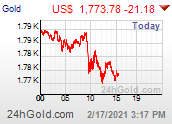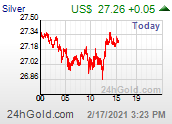Last Updated : 13 December 2012 at 11:35 IST
Why Gold is falling and why it will bounce back
Source :Commodity Online Editorial Desk
Author :Rakesh Neelakandan
By Rakesh Neelakandan
Gold has tumbled for two reasons post the alphanumeric extravaganza, QE4. The primary reason is profit booking and the secondary reason is pessimism pessimism pertaining to US Fiscal Cliff.
“Investors are now focused on the fiscal cliff negotiations, which are looking protracted and threatening to weigh on all markets,” said Xiang Nan, an analyst at CITICS Futures Co., a unit of China’s biggest listed brokerage to Bloomberg.
“ We view a drop below $1,700 as a good buying opportunity. The Fed sent a strong signal about supporting the economy and keeping the easy monetary policy stance unchanged, which should support higher gold prices in the longer term.” Nan added.
If the current budget talks between Republicans and Democrats fail, US is sure to go off the cliff and none other than the Congressional Budget Office has predicted contraction in the economy (read recession) even as $600 billion in spending cuts and tax spikes would come into force on its own. The fragile economy that is the United States of America would come to a grinding halt overnight.
And with the worsening Eurozone crisis, things would go out of hand, analysts say. This scenario is deemed best for gold prices, one would think. But it may not be the case.
In fact, there is a haven that is touted safer than gold: US Dollar!
When I say this, I can hear a din of arguments pouring in, that would postulate Dollar having a value lesser than the paper in which it is printed.
But one should also not miss the fact that Dollar appreciated and gold tumbled in the immediate aftermath of the 2008 crisis.
Why this was so?
One of the reasons behind this appreciation in Dollar was the frantic flight to treasuries by investors. And treasuries are dollar denominated. This suddenly pushed up Dollar demand and the result was that investors liquidated their positions in gold and other asset classes and invested in bonds. Not the other way around!
Nobody can rule out a similar occurrence this time around already heralded by flight from gold investments. Well, that also may not be the ultimate case.
Please be sure that this is not the end of the road for gold: it is just the beginning! In 2008, the crisis was not fundamentally about solvency, but about liquidity. But this time around it is the other way around. The crisis is about whether a government would default on its debt. When you feel that you will not get the money back once you have lent it to a person, would you continue to lend? You won't! Debt-ceiling debate is still active an issue in US.
And when QE measures continue unabated, it is just a question of time, a question of 'when' rather than 'will' for Dollar and its losing of value.
The crisis of confidence would lead capital to fly to safe havens. And gold is just what it is: a safe haven.
December 12, 2012 • 05:35:23 PST Switch out of fiat money and fixed income before it is too late. It is your best chance to stay wealthy and emerge from... Read More
tanglinboy ( Date: 11-Dec-2012 22:41) Posted:
|
Last Updated : 12 December 2012 at 17:00 IST
Gold could rise to $2,000 per ounce in 2013: BofA Merrill Lynch
[ Commodity Online ]
Large-scale policy easing by the U.S. Federal Reserve and European Central Bank positions gold as a useful hedge against global macro and inflation risks taking the commodity to $2000/oz levels, said Bank of America Merrill Lynch in a report that provides for 2013 outlook for global economic front.
BofA Merrill Lynch analysts outlined nine other macro calls on which they are basing their 2013 outlook.
--The global economy grows 3.2 percent, gradually improving through the year, led by China and the U.S. Resolution of the fiscal cliff in the U.S. and successful negotiation of aid to Spain, combined with high liquidity and low commodity prices, should support a gradual improvement in global business and consumer spending through the year. By the end of 2013, growth is expected to rise to 2.5 percent in the U.S. and 8 percent in China.
--Fiscal austerity in the U.S. and Europe offsets monetary stimulus from central banks. Monetary easing may not be enough to offset fiscal contraction in the first part of the year. Fiscal austerity in Europe and in the U.S. – the latter by as much as 2 percent of GDP – is likely to be a drag on growth.
--The U.S. housing recovery builds momentum. U.S. home prices are expected to rise another 3 percent in 2013, adding to the 5 percent gain in 2012. Housing starts could increase by more than 25 percent and a 3.5 percent average annual appreciation over the next 10 years should stimulate jobs to construction and related sectors such as furniture, building materials and financials.
--Flares, not wildfires in Europe. With support to Spain from the European Central Bank, the European economy should stabilize as the year progresses. Despite a series of episodic flare-ups of the ongoing crisis in Europe, the big tail risk of a Eurozone breakup has likely passed.
--China should lead emerging market growth. Against a backdrop of subdued growth in developed markets, GDP growth in emerging markets is expected to recover to 5.2 percent, led by the BRIC economies, particularly China. However, rising inflation could leave emerging market policymakers with little room to ease.
--Global equities should be the best-performing asset class. Powerful policy support, reasonable valuations and receding tail risks should help make global equities the best performing asset class in 2013. The U.S., European and Asian equity markets could see gains of 10 percent to 16 percent next year, with the MSCI AWI reaching 370 and the S& P 500 Index reaching a new all-time high of 1600 by year-end.
--Interest rates and currencies. The U.S. dollar and Euro could rally on the global recovery and greater fiscal clarity, pushing the yen lower and emerging market currencies higher.
--High yield and emerging market bonds should outperform corporate credit. On the heels of record-low yields in 2012, U.S. investment-grade corporate bonds are likely to offer scant returns of 1.6 percent in the year ahead, but high yield bonds could return up to 7.0 percent and emerging market bonds could return 10.1 percent.
--Fixed Income: Government bond yields should rise modestly. G3 central banks are expected to maintain their zero-interest rate policies. Government bond yields in the U.S., U.K. and Germany are expected to rise modestly to 2.0, 2.5 and 1.5 percent, respectively, translating into total returns for major government bond markets of roughly -3 percent to +2 percent.
tanglinboy ( Date: 11-Dec-2012 22:41) Posted:
|
December 10, 2012 • 17:46:50 PST Silver remained the best investment option this year and will be next year as it almost always rises in tandem with the ... Read More
December 10, 2012 • 17:46:50 PST Silver remained the best investment option this year and will be next year as it almost always rises in tandem with the ... Read More
Last Updated : 10 December 2012 at 13:10 IST
MCX Gold: What to expect for the week
Source :Commodity Online Research desk
Author :Ankush Kumar Jain
By Ankush Kumar Jain
MCX Gold February contract is looking positive for the week even as uncertainty returns to plague Eurozone. The contract may have crucial support at Rs.31200 and if that level is breached, prices may move down and touch Rs.30900 levels. The prices may face stiff resistance at Rs 31660 levels.
Traders may take a buying position in gold February contract around Rs.31300 with stop loss of Rs.31200 for the target near Rs. 31600 for this week.
As of 12:41 PM, MCX gold for December delivery was seen trading at Rs.31376, a gain of 0.16% . Gold on the Comex meanwhile was seen trading at $1708.65 an ounce, a gain of 0.18% as of 12.56 PM IST.
The continuing dilemma associated with US fiscal cliff issue and the Eurozone crisis, would continue to lend support to gold prices, analysts say.
Meanwhile, Obama has met with Republican Speaker of the House of Representatives John Boehner on Sunday afternoon:
“This afternoon, the president and speaker Boehner met at the White House to discuss efforts to resolve the fiscal cliff,” White House spokesman Josh Earnest said to the press. “We’re not reading out details of the conversation, but the lines of communication remain open,” he said.
Meanwhile the current Italian Prime Minister Mario Monti is about to quit as the party manned by former PM Silvio Berlusconi has withdrawn support to Monti.
This is sure to usher in more uncertainty to the market floors.
(Ankush Kumar Jain is Manger-Research, metals-energy,Commodity Online)
December 07, 2012 • 16:10:30 PST We face one of the deepest crises in history. A prognosis for the economic future requires a deepening of the concepts o... Read More
i read, i post








